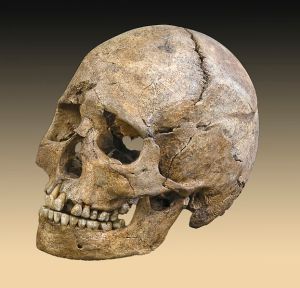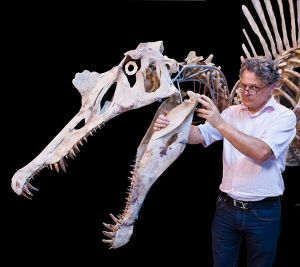
Wikimedia Commons photographer Didier Descouens (User:Archaeodontosaurus) has the unique opportunity to take photos of natural history and paleontology: he is the chair of the Institute of Natural Sciences “Picot de Lapeyrouse” at the Natural History Museum in Toulouse, France. As part of a special arrangement with Wikimedia France and Toulouse Mayor Pierre Cohen, Descouens and his colleagues have spent a year adding quality encyclopedic images to the Commons database as part of Projet Phoebus.
The skull above was part of a famous tomb, from the Téviec region in Brittany, and is dated to approximately 7000 BC, during the Mesolithic era. According to Descouens, the tomb has undergone a complete restoration with a study of paleoanthropology and forensic medicine and is part of an exhibition that originally appeared in Toulouse, but is currently in Paris. The exhibition will then move to the Transvaal Museum in Pretoria, South Africa.
Descouens said there were two skeletons in the tomb, which were originally believed to be of a man and a woman. Through their analysis, they discovered that they were both women and that they had been violently killed. “The skull of the photo shows an impact of arrow, above the right orbital,” said Descouens. “The right side of the skull shows a blow with a hammer.”
As for the significance of the finding, Descouens said, “The image of two women murdered and buried with great care, asks us about our inner nature. 7000 years: that is both far away but frighteningly ‘modern.'”

Descouens is a doctor, a scientific photographer and a naturalist. He has been taking photographs since he was 10 years old and learned scientific photography techniques from François Seguy, who is in charge of photographic works from the Muséum de Toulouse and Université Paul Sabatier. The Muséum de Toulouse has mandated that the “Institute Piot de Lapeyrouse” share photographs from its collections freely. After testing various options, they found Commons to be the most reliable and easiest to use.
In addition to the value of the photos for Wikipedia and Commons, Descouens said scientific organizations have repurposed the images for their materials. The Projet Phoebus images have been used on 283 of the Wikipedia language projects and have also appeared in media stories throughout Europe and in Canada.
The ubiquitous use of the photos pleases Descouens. “Knowledge is the cement that unites us. It is valuable if it is freely shared by all,” he said.
(View more of Descouens’ featured photos)
Story by Matthew Roth, Global Communications Manager
Reporting by Elaine Mao, Communications Intern
Translation by Guillaume Paumier, Technical Communications Manager

Can you help us translate this article?
In order for this article to reach as many people as possible we would like your help. Can you translate this article to get the message out?
Start translation